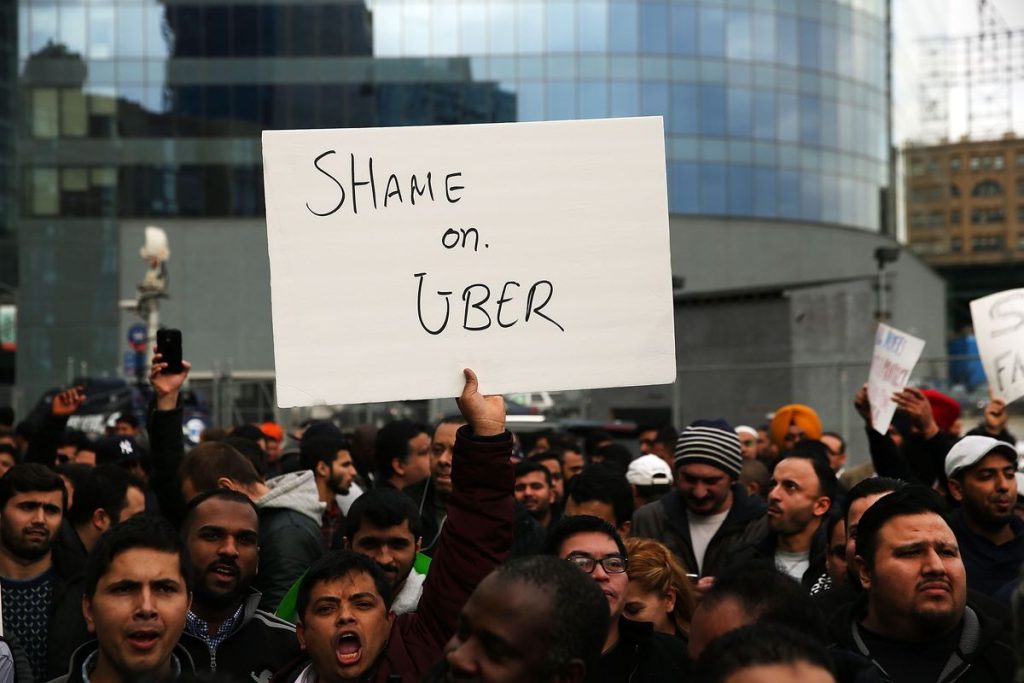In March this year, Uber made 10 years of being at the centre of giving a face to ride-hailing apps and making it seamless and easy.
About a decade ago, Two friends, Travis Kalanick and Garrett Camp, were attending the LeWeb in 2008 in Paris, an annual tech conference the Economist describes as “where revolutionaries gather to plot the future”. It’s from there that they’re believed to have had one winter night during the conference when the pair was unable to get a cab and the scenario birthed the mighty idea of ‘UberCab’ that came to be known today as ‘Uber’.
However, with success, comes its own share of challenges and a dose of controversy for any start-up that is at the pinnacle of rapidly attracting huge amounts of investment & funding. The tremendous growth of Uber and her disruptive technology instantly handed it the ‘accolade’ of the highest valued private start-up company in the world at $70 billion.
Uber has been at the centre of so much controversy that has affected and plugged her valuation and stocks. In 2017, Uber’s overwhelming scandals, blunders and PR disasters saw founder and CEO Travis Kalanick resign following months of chaos. Mr Travis was forced to step down as CEO after facing pressure from investors after volatile six months of scandals and increased ignominy of the company.
The company has been branded a toxic work environment before and suffered a major backlash two years ago and has had to deal with a series of sexist accusations which sparked a social media campaign urging people to #deleteUber (Oh yeah it still does come up again).
As though that is not all, Uber resolved claims by all 50 states that it concealed a massive data breach; persuaded a British judge to undo a ban on its operations in London, and doled out $10 million to more than 400 of its female and minority engineers to make a lawsuit over pay discrimination and sexual harassment go away, reported the Washington Post. Uber also agreed to pay an as-yet-undisclosed amount to end a class action accusing it of putting thousands of women at risk of sexual assault by Uber drivers.
However, with success, comes its own share of challenges and a dose of controversy
The Guardian has also extensively reported about Uber’s steady stream of scandals and negative publicity in recent years, including revelations of questionable spy programs, a high-stakes technology lawsuit, claims of sexual harassment and discrimination and embarrassing leaks about executive conduct.
What Went Wrong?
But how did a seemingly successfully start-up all of a sudden become a hotbed of controversies? How did Uber start having all these problems at the same time forcing the resignation of its founder?
When the idea of Uber was birthed, the model was to find individuals that owned cars and were interested in making an extra buck at their own convenience. Uber’s disruptive technology idea of connecting independent car owners to those in need of a ride proved to be a stunner but could have been the genesis of their woes according to some pundits.
Because they (founders) didn’t own any cars, it was hard for them to have a strong legal framework to govern their operations and thus operated based on fundamental illegality. The model of simply hiring individuals that owned cars exposed them to great risks and loopholes such as the absence of scrutiny for everyone that used or joined their platform. In his Havard Business Review in 2017, Mr Benjamin Edelman noted that this approach allowed Uber and its drivers to avoid a litany of requirements such as insurance, registration, inspections “and countless other expenses”.


Courtesy Getty Images
The consequences of Uber’s actions soon caught up with them; In 2014, taxi drivers in London, Berlin, Paris, and Madrid staged a large-scale protest against Uber. Taxi companies claimed that since Uber avoids their expensive license fees and bypasses local laws it creates unfair competition. The case was heard by Europe’s top court in December 2016. Uber lost its license to operate in London where the company had 40,000 registered drivers in October 2017.
Recruiting individuals as Uber drivers also created a huge problem for Uber as it later caused confusion as to whether they remained independent contractors or must be treated like Uber employees. For a then start-up like Uber, they could have been keeping costs down but the move proved to harm them terribly forcing them to pay huge sums to settle complaints brought by women who have continuously said they were raped or assaulted by Uber drivers.
On June 13, 2017, a New York judge ruled that Uber drivers should be considered as employees as opposed to being independent contractors like the company had argued, at least in certain cases. This opened up for drivers to receive employee benefits, which would likely have a significant impact on the bottom line.
Uber Drivers have now and then continued to feel increasingly poor, angry and powerless as their wages continue to also drastically decrease and are always crying foul-play. This could be the reason for their disgruntled-ness. Ahead of the IPO, the drivers’ wages have been cut & the bonuses offered to long-term drivers by Uber and Lyft, its main rival, are inadequate.
In the other news, the world’s largest ride-hailing company, Uber plans to offer its shares to investors for $44 to $50 each, putting its total valuation between $80 billion and $90 billion.





Comments